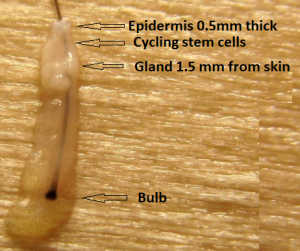I have added a link to some of the before and after pics of people who have apparently used the lasercomb.
What do you think?
https://www.lasercomb.net/beforeafter.htm
Thanks again Dr! I’m addicted to your site now!!!
Ah, the HairMax LaserComb by Lexington International. It’s worth noting that lasercomb.net and hairmax.com both go to the exact same site, so the link you sent is the official site of this product. The page you sent (linked above) has 2 groups of photographs, each with multiple before/after sets. The 1st group is apparently patient results, and the 2nd group is of clinical trial macro photos.
So let’s start with the first group of photos — the patient results. I looked carefully at these, and there is a real question in my mind as to what I am seeing. A few of these pictures have longer hair that is possibly responsible for the changes that I can see. I wanted to get an enlarged version of the photos to see the details that would tell me what I was looking at, but they are not available on the site. The first before/after set in the group are a good example to start with. There is a suggestion that the scalp has coloring to it (Dermatch or something similar), but as I can’t enlarge the photos, I can’t try to determine what it might be. Could the difference be lighting or combing style? I don’t know, honestly. Many of the photographs suggest styling differences. In no case was there any significant change in the hair coverage, though. Either the person had plenty of hair when they started or there was not enough hair when they finished treatment.
Moving on to the 2nd group of pictures, the clinical trial macro photos —
We analyzed two sets of the before/after high-powered magnification photos, which also includes the data that they based their research upon. The actual hair counts as they did them are well presented and can be seen by magnifying the circular areas of hair density assessments. Each hair grouping was identified, numbered, and the authors put the actual count on each follicular unit as they made the measurement. They did not separate or identify those hairs that were miniaturized. Because all of the information is present in the material presented on their website, it was easy for us to repeat their measurements and to ascertain if their numbers corresponded to an independent assessment.
Here’s a breakdown of what I found in the macro photos that Hairmax presents on their LaserComb site.
Macro Photo Set 1 – Before picture:
- HairMax’s hair count: 107
- My hair count: 115
- Of these hairs, 12 were miniaturized
Macro Photo Set 1 – After picture:
- HairMax’s hair count: 148
- My hair count: 128
- Of these hairs, 10 were miniaturized
See the image on the LaserComb site
Statistically, the percent difference between the before and after photos (according to my count) is insignificant. Therefore, in the first set of photos the LaserComb made no real difference.
In the second sequential set of photos, I discovered that the after photo actually had less hair than the before photo —
Macro Photo Set 2 – Before picture:
- HairMax’s hair count: 147
- My hair count: 161
- Of these hairs, 12 were miniaturized
Macro Photo Set 2 – After picture:
- HairMax’s hair count: 184
- My hair count: 159
- Of these hairs, 10 were miniaturized
See the image on the LaserComb site
Yes, I actually counted three fewer hairs after the LaserComb was used. My measurements of the data on their official site do not support the findings they offer.
I am comfortable saying that I am one of the world’s experts in hair densitometry. I can prove this as I am the inventor of this technology and hold the U.S. Patent on the instruments used by HairMax (or Lexington International) to demonstrate their findings (see: USPTO.gov). With that being said, I reviewed our findings and agree with our counts. I believe that HairMax’s photos do not show any objective evidence of hair growth on the first two sets of data and that the numbers that they derived do not correspond to the assessments made by us. Lots of good hype if you’re into it.


